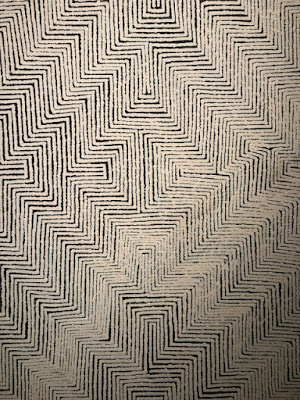Our grand parenting duties shrink back as our granddaughter gets older and has more autonomy and more activities to fill up her time. That's not a bad thing. We still get to spend lots of time with our daughter and granddaughter, but I also have plenty of time to read, think, write, and delete emails that never seem to slow down. Even as I unsubscribe to emailers I never subscribed to, new ones seem to find me.
But we had an anniversary yesterday and we decided to take the ferry and wander around downtown Seattle.It's been pretty rainy, but the sun made itself known as we approached the ferry terminal.
We tried the post office on 1st Street, but it was closed for lunch.
So we made our way to Pike Place Market for some clam chowder. The seats weren't that comfy, but the chowder was hot and the guy with the red sleeves kept up a constant entertaining chatter.

"The French nobleman Charles d'Amboise became the governor of the Duchy of Milan after it was conquered by France. The collar of scallop shells and knots denotes the Order of SaintMichael, granted to him about 1505, perhaps the occasion for commissioning this portrait.
D'Amboise was a friend and patron of Leonardo da Vinci, but he hired a more conservative artist for his portrait and chose to be portrayed in a classic profile view, which records his features but provides no psychological insight. He most likely wanted to link his image with the great rulers of the ancient past, depicted in side views on coins and medals like those shown in the case nearby D'Ambroise himself was an avid coin collector as he proudly demonstrates here."
"Eros and Psyche appear in Greek art as early as the 4th century BC"
The curator wrote the following to accompany this painting:
"The jealous goddess Venus sent her son Cupid to make Psyche fall in love with a horrible monster. Instead, Cupid became enamored himself and installed Psyche in a palace where he visited her at night so that she couldn't learn his identity. One night she stole a peek at his beautiful face. Startled awake, Cupid left immediately, and his palace vanished. Psyche wandered the earth search for her lover, performing impossible tasks set by Venus in hopes of winning him back. Finally, Jupiter intervened: he made Psyche a goddess and reunited her with Cupid, giving their story a happy ending. Here Cupid has just abandoned Psyche, who chases him as he hovers out of reach. This moment allows Colombel, a French artist who was trained in Rome, to show the Roman countryside - the appropriate setting for this classical myth."
So this story goes back 2500 years, yet we have the same human emotions and conflicts: a woman possibly falling in love with a monster (how many battered wives are there today?); a forbidden young love; a jealous and vengeful mother-in-law (no they aren't married, but Venus was Cupid's mother). I'm not sure why the curator thinks the Roman woods to be the appropriate background, perhaps because the Romans appropriated much of Greek culture including their myths.
I knew from the beginning this post was going to be much too long, so let me jump to another exhibit - this of Ausralian aboriginal artists.
These large detailed paintings speak to me in a language I can't identify. They tell stories of people and worlds I do not know. Yet they move me a great deal. This is a beauty and a visual language that still exists, outside of Western culture.
"Lightning bolts that ignite the sky are the source for this striking white maze. Kalipinypa is an important site where ancestral forces swept in with a huge storm that caused lightning to flash and water to rush across the country. They left behind a rock hole surrounded with sandhills that are seen here as vibrant patterns created by dotting that fuses into lines that wiggle ever so slightly. Elizabeth Marks Nakamara was married to the renowned artist Mick Namarari. She watched his painting for years but did not begin to paint herself until after his death in 1998."
"'Dreaming is an all-embracing concept that provides rules for living, a moral code, as well as rules for interacting withthenatural environment' - Jeannie Herbert Nungwarrayi(Walpiri speaker) 2000Dreaming is known by Pintupi speakers as Tjukurrpa. Tjukurrpa is called a template for a dynamic duty or way of observing laws passed down by ancestors - the powerful shape-shifting creators who formulated the earth's features, people, and culture. Dreamings stimulate intellectual and emotional life, as people recall extensive genealogies and ceremonial song cycles that describe the ancestors' adventures. No country - the lands, waters, flora, and fauna of an area - is without a trail of their presence, which offers a living continuum of wisdom for all to learn from.Dotting was a biodegradable at for for centuries - on ceremonial objects, in sand paintings, and on painted and adorned bodies. Dots of ochres, down, feathers, and leaves could at times totally overcome a human form, enabling dancers to enter a mythic envelope as they enacted ceremonies. Dots began appearing in painting as a echo of this sacred significance. Some contend they help conceal sacred knowledge, and others suggest they express the flash of ancestral power.'







No comments:
Post a Comment
Comments will be reviewed, not for content (except ads), but for style. Comments with personal insults, rambling tirades, and significant repetition will be deleted. Ads disguised as comments, unless closely related to the post and of value to readers (my call) will be deleted. Click here to learn to put links in your comment.